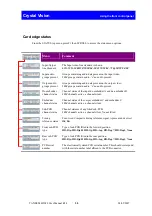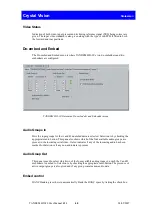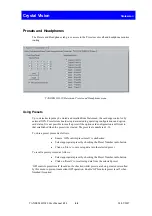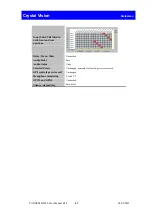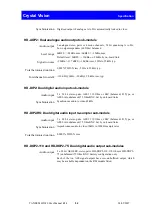
Crystal Vision
Statesman
TANDEM HD-20 User Manual R1.4
42
24/05/2007
Stereo to Mono conversion
For the purposes of this discussion, it is assumed that all inputs are stereo pairs and that each
half of the stereo pair is on a consecutive input i.e. input 1 and input 2 are a stereo pair, input 3
and input 4 are a stereo pair, etc.
The action of converting a stereo pair to a mono output is simply a summing process followed
by a gain correction. The gain correction is necessary because when the two components of a
stereo signal are summed a 6dB increase in output level will result; this will then need to be
corrected to maintain unity gain.
The action of ticking a check box will cause that channel to output the mono sum of itself and
its associated channel. The associated channel will still output its unaltered programme. Either
channel of a pair can be selected for stereo to mono conversion.
Example: Ticking channel 1 mono check box will result in channel 1 outputting the converted
mono sum of channels 1 and 2. Channel 2 will remain outputting the original channel 2
programme. Similarly un-ticking channel 1 and ticking channel 2 will cause channel 2 to
output the converted mono programme and channel 1 the original channel 1 programme.
Editing router input and output names
Each of the input and output names may be edited for both embed and output routers.
Changing router input name
Changing router output name
To edit a source or destination name click on the Input or Output text, and a Rename menu
will appear. Enter the desired names in the box provided and click OK. The new name will be
stored in the host PC, and appear each time Statesman is used.
Delay control
This control can be used to delay the audio with respect to the video by up to 64ms and
compensate for any small delay between the incoming video and audio signals. The delay is
applied at the output of the 16x8 router and is a single global control. To add a delay to any
channels tick the adjacent check box.



